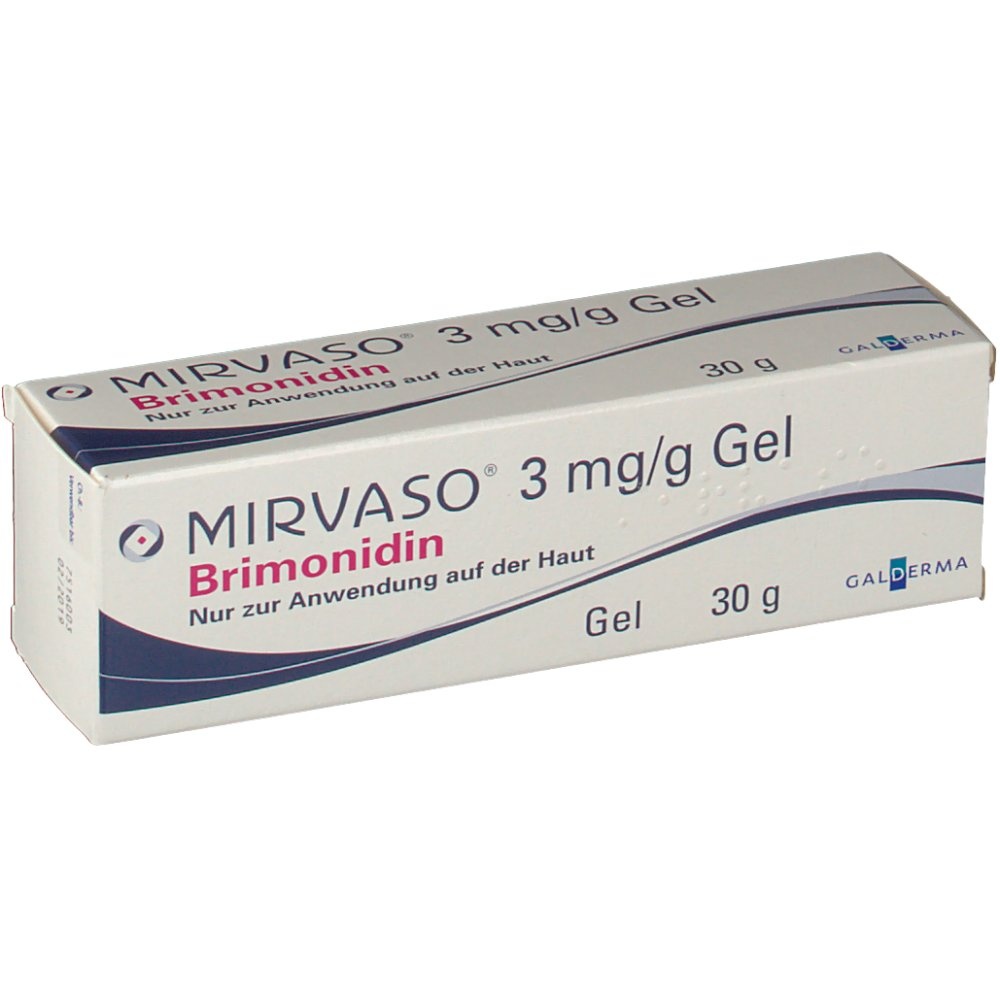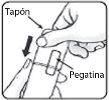
How to use MIRVASO 3mg/g cream
Introduction
Package Leaflet: Information for the Patient
Mirvaso 3 mg/g Gel
brimonidine
Read all of this leaflet carefully before you start using this medicine because it contains important information for you.
- Keep this leaflet, you may need to read it again.
- If you have any further questions, ask your doctor or pharmacist.
- This medicine has been prescribed for you only. Do not pass it on to others. It may harm them, even if their signs of illness are the same as yours.
- If you get any side effects, talk to your doctor or pharmacist. This includes any possible side effects not listed in this leaflet. See section 4.
Contents of the pack
- What is Mirvaso and what is it used for
- What you need to know before you use Mirvaso
- How to use Mirvaso
- Possible side effects
- Storage of Mirvaso
- Contents of the pack and other information
1. What is Mirvaso and what is it used for
Mirvaso contains the active substance brimonidine, which belongs to a group of medicines commonly known as “alpha agonists”.
It is applied to the skin of the face to treat redness caused by rosacea in adult patients.
Facial redness due to rosacea is caused by high levels of blood flow in the skin of the face, which is the result of an increased size (dilation) of the small blood vessels in the skin.
When applied, Mirvaso works by narrowing these blood vessels, which reduces excess blood flow and redness.
2. What you need to know before you use Mirvaso
Do not use Mirvaso:
- if you are allergic to brimonidine or any of the other ingredients of this medicine (listed in section 6).
- in children under 2 years of age, as they may have a higher risk of side effects to any medicine that is absorbed through the skin.
- if you are taking certain medicines used for depression or Parkinson's disease, including those called monoamine oxidase inhibitors (MAOIs) (e.g. selegiline or moclobemide) or tricyclic antidepressants (such as imipramine) or tetracyclic antidepressants (such as maprotiline, mianserin or mirtazapine). The use of Mirvaso when taking these medicines may cause a drop in blood pressure.
Warnings and precautions
Consult your doctor or pharmacist before starting treatment with Mirvaso, especially if:
- the skin on your face is irritated or has open wounds.
- you have heart or blood circulation problems.
- you have depression, decreased blood flow to the brain or heart, low blood pressure when standing up, decreased blood flow to the hands, feet or skin, or Sjögren's syndrome (a chronic disease in which the body's natural defenses - the immune system - attack the moisture-producing glands).
- you have kidney or liver problems, or have had them in the past.
- you have undergone or are planning to undergo a laser procedure on the skin of your face.
It is important to start treatment with a small amount of gel, gradually increase the dose, but do not exceed the maximum dose of 1 gram (approximately a pea-sized amount). See also the instructions “How to use Mirvaso”.
Do not apply Mirvaso more than once a day and do not exceed the maximum daily dose of 1 g (approximately a pea-sized amount). See also the instructions “How to use Mirvaso”.
Worsening of skin redness, flushing, or burning sensation:
Up to 1 in 6 patients experience worsening redness. This worsening of redness usually develops within the first 2 weeks of treatment with Mirvaso. It usually disappears on its own after stopping treatment. The effect should disappear gradually over a few days in most cases. Before resuming treatment with Mirvaso gel, test it on a small area of the face for one day when you can stay at home. If you do not experience worsening redness or burning sensation, continue with your usual treatment (see section 3).
If you experience worsening or unexpected redness, stop treatment and contact your doctor.
If any of the above applies to you, talk to your doctor, as this medicine may not be suitable for you.
Children and adolescents
Do not give this medicine to children and adolescents under 18 years of age, as safety and efficacy have not been established in this age group. This is especially important in children under 2 years of age (see “Do not use Mirvaso”).
Other medicines and Mirvaso
Tell your doctor or pharmacist if you are taking, have recently taken, or might take any other medicines, as these medicines may affect your treatment with Mirvaso or Mirvaso may affect your treatment with these medicines.
Do not use Mirvaso with selegiline, moclobemide, imipramine, mianserin, or maprotiline, which are medicines used for depression or Parkinson's disease, as it may cause a change in the effectiveness of Mirvaso or increase the chances of side effects such as low blood pressure (see “Do not use Mirvaso”).
Also, tell your doctor if you are taking any of the following medicines:
- medicines used to treat pain, sleep disorders, or anxiety disorders.
- medicines used to treat psychiatric disorders (chlorpromazine) or used to treat hyperactivity (methylphenidate) or used to treat high blood pressure (reserpine).
- medicines that work in the same way as Mirvaso (other alpha agonists, e.g. clonidine; alpha blockers or antagonists, e.g. prazosin, isoprenaline, which are mainly used to treat high blood pressure, slow heart rate, or asthma).
- cardiac glycosides (e.g. digoxin), used to treat heart problems.
- medicines to lower blood pressure, such as beta blockers or calcium channel blockers (e.g. propranolol, amlodipine)
If any of the above applies to you, or if you are not sure, talk to your doctor.
Using Mirvaso with alcohol
Tell your doctor if you regularly drink alcohol, as this may affect your treatment with this medicine.
Pregnancy and breastfeeding
Mirvaso is not recommended during pregnancy, as its effects on the fetus are unknown. You should not use this medicine during breastfeeding, as it is unknown whether this treatment passes into breast milk.
If you are pregnant or breastfeeding, think you may be pregnant, or are planning to have a baby, ask your doctor for advice before using this medicine.
Driving and using machines
Mirvaso has a negligible influence on the ability to drive and use machines.
Mirvaso contains methyl parahydroxybenzoate (E218), which may cause allergic reactions (possibly delayed). This medicine also contains 55 mg of propylene glycol (E1520) per gram, which is equivalent to 5.5% w/w, which may cause skin irritation.
3. How to use Mirvaso
Follow exactly the instructions for administration of this medicine given by your doctor. If you are unsure, consult your doctor or pharmacist again.
Important:Mirvaso is indicated for adults and for use on the skin of the face only. Do not use this medicine on other parts of your body, especially on moist surfaces of the body, e.g. the eyes, mouth, nose, or vagina.
Do not ingest.
Keep Mirvaso out of the reach of children.
How to use Mirvaso
Mirvaso should be applied to the face only once a day.
During the first week, start treatment with a small amount of gel (a pea-sized amount) as indicated by your doctor or nurse.
If symptoms persist or only improve slightly, you may then gradually increase the amount of gel used. Spread a very thin layer smoothly and evenly as indicated by your doctor or nurse. It is important not to exceed the maximum daily dose of 1 gram (approximately a pea-sized amount applied to the entire face).
Wash your hands immediately after applying this medicine.
If you experience worsening of symptoms during treatment with Mirvaso (increased redness or burning sensation), stop treatment and make an appointment with your doctor. See also section 2 “Warnings and precautions”.
You should apply a small amount of gel, the size of a pea, to the forehead, chin, nose, and both cheeks, and then spread a thin layer smoothly and evenly over each area. Do not exceed the recommended total daily dose (5 pea-sized amounts). Avoid the eyes, eyelids, lips, mouth, and inside of the nostrils. If you apply the product to these areas, rinse them immediately with plenty of water. If you experience worsening redness or burning sensation, stop using Mirvaso and contact your doctor if necessary.
Do not apply any other skin medicine or cosmetics immediately before the daily application of Mirvaso.
You should use these products only after applying Mirvaso, once it has dried. Wash your hands immediately after applying this medicine.
Be careful when opening the tube/pump for the first time, to avoid spilling more gel than necessary. If this happens, discard the excess gel to avoid applying more than the recommended dose. See the previous paragraph “How to use Mirvaso”.
[EU/1/13/904/004-006, EU/1/13/904/008-009]
How to open the child-resistant tube
Do not squeeze the tube when opening or closing it to avoid spilling.
Press the cap and turn it counterclockwise (to the left). Then remove the cap.
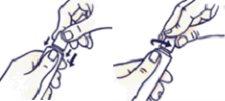
How to close the child-resistant tube
Press and turn clockwise (to the right).
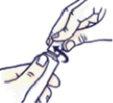
[EU/1/13/904/007]
How to open the child-resistant pump
Press the cap and turn it counterclockwise (to the left).
Note: when the cap is removed, the pump is no longer child-resistant.
|
|
Before using it for the first time, prime the pump. To do this, press the pump several times until the medicine comes out.
To apply Mirvaso gel to the face, put a pea-sized amount of Mirvaso gel on the tip of your finger. Continue pressing down on the pump to get the amount you need according to your doctor's prescription (but no more than 5 pea-sized amounts in total).
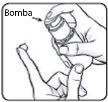
To close the pump, put the cap back on. Press the cap and turn it clockwise (to the right) until it stops. The pump will be child-resistant again.

If you use more Mirvaso than you should
If you use more than the maximum daily dose of 1 gram in a 24-hour period, this could cause skin irritation or other side effects at the application site. Repeated doses in the same 24-hour period could cause side effects such as low blood pressure, numbness, or drowsiness.
Contact your doctor, who will advise you on what action to take.
If someone, especially a child, accidentally ingests Mirvaso, they may experience serious side effects and need hospital treatment.
Consult your doctor immediately or go to the hospital emergency department if you, a child, or someone else ingests this medicine and experiences any of these symptoms: dizziness due to low blood pressure, vomiting, tiredness or drowsiness, slow or irregular heartbeats, constriction of the pupils, difficulty or low frequency breathing, weakness, low body temperature, and convulsions. Bring the medicine packaging with you so that the doctor knows what has been ingested.
If you forget to use Mirvaso
Mirvaso works daily, starting from the first day of treatment. If you miss a daily dose, the redness will not decrease that day. Do not apply a double dose to make up for missed doses, and continue your treatment as prescribed.
If you stop treatment with Mirvaso
A possible consequence of stopping treatment before finishing it is that the disease may return to its initial state. Please ask your doctor before stopping treatment, so that they can advise you on a substitute treatment if necessary.
If you have any further questions on the use of this medicine, ask your doctor or pharmacist.
4. Possible side effects
Like all medicines, this medicine can cause side effects, although not everybody gets them.
If you experience uncommon side effects such as severe skin irritation or inflammation, skin rash, pain or discomfort in the skin, dry skin, sensation of heat in the skin, tingling or sensation of pins and needles, swelling of the face, or common side effects such as worsening of rosacea, stop treatment and talk to your doctor, as this medicine may not be suitable for you. In some cases, symptoms can extend beyond the treated area. See also section 2 “Warnings and precautions”.
If you develop contact allergy (e.g. allergic reaction, skin rash) or rare angioedema (severe allergic reaction that usually causes swelling of the face, mouth, or tongue), stop using Mirvaso and seek medical advice soon.
Mirvaso may also cause the following side effects:
Common side effects (may affect up to 1 in 10 people):
- flushing
- excessive paleness (pallor) at the application site
- skin redness, burning sensation, or itching
Uncommon side effects (may affect up to 1 in 100 people):
- acne
- nasal congestion
- headache
- worsening of rosacea
- swelling of the eyelids
- sensation of heat
- cold sensation in hands and feet
- dry mouth
- hives
- dizziness
Rare side effects (may affect up to 1 in 1,000 people):
- low blood pressure (hypotension)
- decreased heart rate (bradycardia, slow heart rate)
Reporting of side effects
If you experience any side effects, talk to your doctor or pharmacist. This includes any possible side effects not listed in this leaflet. You can also report side effects directly via the national reporting system listed in Appendix V. By reporting side effects, you can help provide more information on the safety of this medicine.
5. Storage of Mirvaso
Keep this medicine out of the sight and reach of children.
Do not use this medicine after the expiry date which is stated on the carton, tube, and pump after EXP. The expiry date is the last day of the month stated.
This medicine does not require any special storage conditions.
Store below 30°C and do not freeze.
Medicines should not be disposed of via wastewater or household waste. Ask your pharmacist how to dispose of medicines no longer required. This will help protect the environment.
6. Container contents and additional information
Mirvaso composition
- The active ingredient is brimonidine. One gram of gel contains 3.3 mg of brimonidine, equivalent to 5 mg of brimonidine tartrate.
- The other components are carbomer, methylparahydroxybenzoate (E218), phenoxyethanol, glycerol, titanium dioxide, propylene glycol (E1520), sodium hydroxide, purified water. See the end of section 2 for information related to methylparahydroxybenzoate and propylene glycol.
Appearance of the product and container contents
Mirvaso is an opaque gel between white and light yellow. It is presented in tubes with 2, 10 or 30 grams of gel or in an airless pump system that contains 30 g of gel.
Container with 1 tube or 1 pump.
Only some pack sizes may be marketed.
Marketing authorization holder
Galderma International
Tour Europlaza, 20 avenue André Prothin – La Défense 4
La Défense Cedex 92927
France
Manufacturer
Laboratoires Galderma
Z.I. Montdésir
74540 Alby-sur-Chéran
France
or
Galderma Laboratorium GmbH
Toulouser Allee 19a-23a,
Pempelfort,
Duesseldorf,
North Rhine-Westphalia
40211,
Germany
You can request more information about this medication by contacting the local representative of the marketing authorization holder:
Austria Galderma Austria GmbH Tel: 0043 732 715 993 e-mail: [email protected] | Italy Galderma Italia S.p.A. Tel: + 39 337 1176197 e-mail: [email protected] |
Belgium/Belgique/Belgien Luxembourg/Luxemburg Galderma Benelux BV Tel: +31 183691919 e-mail: [email protected] | Latvia Tamro SIA, Latvia Tel. +371 67067800 |
PHOENIX PHARMA EOOD, Bulgaria Tel. +359 2 9658 100 | Lithuania Tamro UAB, Lithuania Tel. +37037401099 |
Czech Republic Slovak Republic 4 LIFE PHARMA CZ, s.r.o. Czech Tel. +420 244 403 003 | Hungary Ewopharma Hungary Kft. Tel.: +36 1 200 4650 e-mail: [email protected] |
Denmark Norway Iceland Finland Sweden Galderma Nordic AB Tel: + 46 18 444 0330 e-mail: [email protected] | Malta Prohealth Limited Tel. +356 21461851, +356 21460164 e-mail: [email protected] |
Germany Galderma Laboratorium GmbH Tel: + 49 (0) 800 – 5888850 e-mail: [email protected] | Netherlands Galderma Benelux BV Tel: + 31 183691919 e-mail: [email protected] |
Estonia Tamro Eesti OÜ, Estonia Tel. +372 650 3600 | Poland Galderma Polska Sp. z o.o. Tel.: + 48 22 331 21 80 e-mail: [email protected] |
Greece Cyprus Pharmassist Ltd Tel: + 30 210 6560700 e-mail: [email protected] | Portugal Laboratorios Galderma, SA – Sucursal em Portugal Tel: + 351 21 315 19 40 e-mail: [email protected] |
Spain Laboratorios Galderma SA Tel: + 34 902 02 75 95 e-mail: [email protected] | Romania Neola Pharma SRL Tel: + 40 21 233 17 81 e-mail: [email protected] |
France Croatia Ireland Slovenia Galderma International Tel: +33 08.00.00.99.38 e-mail: [email protected] | United Kingdom (Northern Ireland) Galderma (UK) Ltd. Tel: + 44 (0) 300 3035674 e-mail: [email protected] |
Date of the last revision of this prospectus:
Detailed information on this medication is available on the European Medicines Agency website: http://www.ema.europa.eu.
- Country of registration
- Active substance
- Prescription requiredYes
- Manufacturer
- This information is for reference only and does not constitute medical advice. Always consult a licensed doctor before taking any medication. Oladoctor is not responsible for medical decisions based on this content.
- Alternatives to MIRVASO 3mg/g creamDosage form: GEL, 3mg / 1 mgActive substance: brimonidineManufacturer: Galderma InternationalPrescription requiredDosage form: GEL, 3mg/gActive substance: brimonidineManufacturer: Galderma InternationalPrescription requiredDosage form: GEL, 3mg / 1 mgActive substance: brimonidineManufacturer: Galderma InternationalPrescription required
Alternatives to MIRVASO 3mg/g cream in other countries
The best alternatives with the same active ingredient and therapeutic effect.
Alternative to MIRVASO 3mg/g cream in Poland
Alternative to MIRVASO 3mg/g cream in Ukraine
Online doctors for MIRVASO 3mg/g cream
Discuss dosage, side effects, interactions, contraindications, and prescription renewal for MIRVASO 3mg/g cream – subject to medical assessment and local rules.



